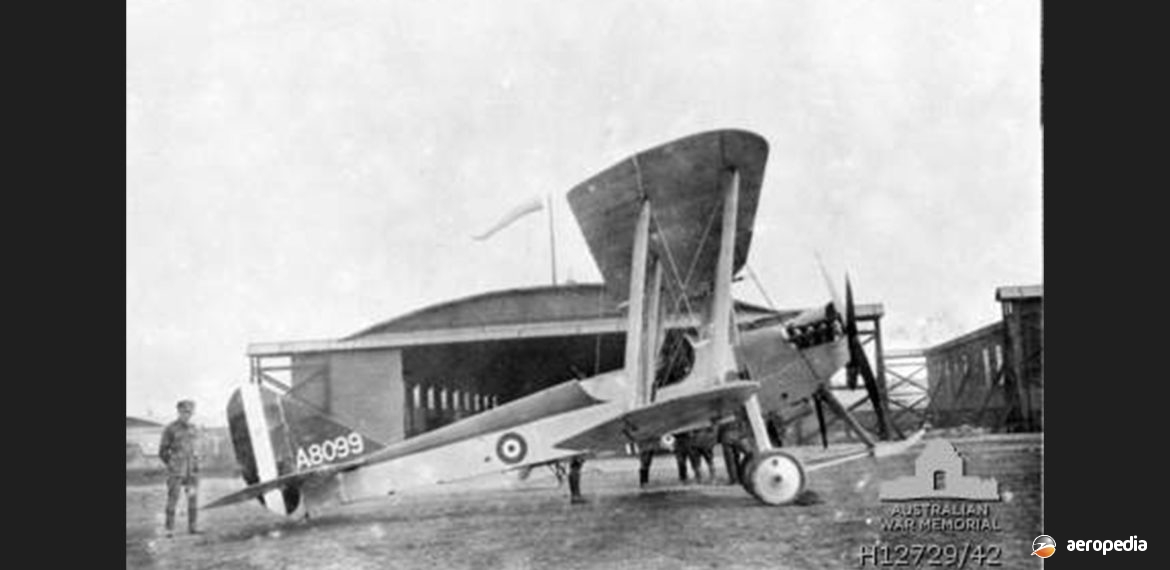Photograph:
Armstrong Whitworth FK.3 serial A8099 operating with the AFC in the United Kingdom (AWM H12729-42)
Country of origin:
United Kingdom
Description:
Two-seat fighting scout
Power Plant:
One 67 kw (90 hp) RAF 1A eight-cylinder VEE liquid-cooled piston engine
Specifications:
- Wingspan: 12.19 m (40 ft 0⅝ in)
- Length: 8.84 m (29 ft)
- Height: 3.63 m (11 ft 10¾ in)
- Wing area: 41.1 m² (442 sq ft)
- Max speed at sea level: 140 km/h (87 mph)
- Max speed at 2,438 m (8,000 ft): 130 km/h (81 mph)
- Service ceiling: 3,660 m (12,000 ft)
- Climb to 1,524 m (5,000 ft): 19 mins
- Climb to 3,048 m (10,000 ft): 48 mins 56 secs
- Endurance: 3 hours
- Empty weight: 629 kg (1,386 lb)
- Loaded weight: 983 kg (2,056 lb)
Armament:
One 7.69 mm (0.303 in) Lewis machine gun in rear cockpit; up to 51 kg (112 lb) of bombs if aircraft flown as pilot only
History:
When it became evident in the British summer of 1914 that war was inevitable, the British Government ordered the RAF BE.2c into production and contracts were awarded to a number of manufacturers to build the type, including Sir W G Armstrong Whitworth & Co Ltd of Gosforth, Newcastle on Tyne. However, management of Armstrong Whitworth formed the view the RAF BE.2 was unnecessarily complicated, it was a bad proposition for it to be put into production, and undertook to build an aircraft which would be equally efficient but structurally simpler. Approval was given to produce a new type.
Chief designer at the time at Armstrong Whitworth was Frederick Koolhoven, who had joined the Company in 1914 upon the formation of the Aeroplane Department . He had previously been involved in designs for the Deperdussin company, and his first design for Armstrong Whitworth was a single-seat scout biplane with a 37 kw (50 hp) Gnome rotary engine, which made its first appearance in September 1914. In answer to the BE.2 he produced the FK.3, an inherently stable two-seat biplane in which the positions of pilot and observer were reversed, the observer being able to use the Lewis gun more effectively to the rear. Power plant was the 67 kw (90 hp) RAF 1A, but at least one example was flown with the RAF 1Ba engine, this being a development with a bigger bore which provided 78 kw (105 hp).
Various tests were carried out on the design, one being fitted with a third mainplane in 1915 and flown as a triplane. As the more potent Armstrong Whitworth FK.8 and RAF RE.8 soon became available, it was not used operationally in France. At one stage, due to a shortage of engines, 12 aircraft were fitted with the 90 kw (120 hp) Beardmore six-cylinder in-line liquid-cooled engine.
Production of the FK.3 was undertaken by Armstrong Whitworth and Hewlett & Blondeau Ltd, but only a small number saw operational service, and those which did formed part of the equipment of No 47 Squadron, RFC in Macedonia, serving at Salonika from September 1916 to 1918. Known as ‘the Little Ack’ it was used for reconnaissance duties and other contact patrols, occasionally making bombing attacks but only when flown solo, the aircraft being incapable of lifting an observer and a worthwhile bomb load simultaneously.
The type is best remembered for its use in the training role and in that capacity it served at many aerodromes in the United Kingdom and in Egypt. As such it was considered a good trainer because of its viceless flying characteristics. It was lighter on the controls than the de Havilland DH.6 or the RAF BE.2c. Eventually it was replaced from 1917 onwards by the Avro 504 series but also served at Schools of Aerial Gunnery. It saw service with No 31 Training Squadron at Wyton, No 35 Reserve Squadron at Northolt, the Schools of Aerial Gunnery at Hythe and Turnberry, and at Stirling, Dymchurch and Marske.
No 3 Squadron Australian Flying Corps (AFC) has been reported to have used the type for training when it was introduced to the unit at South Carlton in Lincolnshire but only used them for a few weeks before they were replaced by the RAF RE.8, the aircraft operating in RAF markings. No 8 (Training) Squadron based at Hythe in Kent, which was an AFC unit, has also been recorded as operating the type.

